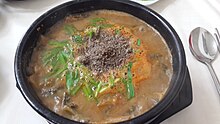Chueo-tang
 Chueo-tang served with perilla seed powder | |
| Alternative names | Loach soup |
|---|---|
| Type | Tang |
| Place of origin | Korea |
| Associated cuisine | Korean cuisine |
| Main ingredients | Pond loach |
| Korean name | |
| Hangul | 추어탕 |
|---|---|
| Hanja | 鰍魚湯 |
| Revised Romanization | chueo-tang |
| McCune–Reischauer | ch'uŏ-t'ang |
| IPA | [tɕʰu.ʌ.tʰaŋ] |
Chueo-tang (Korean: 추어탕) or loach soup[1] is a Korean tang (soup) that prominently features pond loach, a freshwater fish.[2][3] The city of Namwon in southwestern South Korea is known for its version of the dish.[4][5][6]
Etymology
[edit]Chueo (추어; 鰍魚) is a nickname for pond loach, called mikkuraji (미꾸라지) in Korean. Tang (탕; 湯) means soup.
History and tradition
[edit]As irrigated rice paddies are drained after chubun (autumnal equinox), chubby pond loaches, ready for hibernation, are easily caught in the ditches dug around paddy fields.[7] Chueo-tang (추어탕) is often a featured dish in banquets for the elderly.[7]
In Hanyang (now Seoul) during the Joseon era, the guild of licensed panhandlers mandated that its members beg only for bap (cooked rice), not banchan (side dishes) or guk (soup).[7] (The practice was intended to maintain dignity and differentiate members from unlicensed beggars.) As an accompaniment to the rice, Panhandlers hunted pond loaches and made chueo-tang. They were also granted the exclusive rights to sell chueo-tang in the city.[7]
The third-oldest operating restaurant in Seoul, Yonggeumok,[8] specializes in the Seoul style of the dish. In the Seoul style, the fish are served whole, and the soup base uses chili pepper flakes instead of gochujang.[9]
Preparation
[edit]Pond loaches are boiled in water until very tender, and sieved to remove bones and skins.[10] The sieved flesh along with beef or chicken broth is then boiled again and seasoned with gochujang (chili paste), doenjang (soybean paste), grated ginger, and ground black pepper.[10] Vegetable ingredients include mung bean sprouts, Asian royal fern, scallions, napa cabbages, and mustard greens.[10] The soup is often served with ground chopi peppercorns, along with Korean mint leaves (in Yeongnam region) or perilla powder (in Honam region).[11]
See also
[edit]- Dojō nabe, Japanese pond loach stew
- List of soups
References
[edit]- ^ "Loach Soup Recipe". Simple Chinese Food. 2021-09-17.
- ^ "주요 한식명(200개) 로마자 표기 및 번역(영, 중, 일) 표준안" (PDF). National Institute of Korean Language (in Korean). 30 July 2014. Retrieved 16 February 2017.
- 주요 한식명 로마자 표기 및 표준 번역 확정안 공지. National Institute of Korean Language (Press release) (in Korean). 2014-05-02.
- ^ Jeon, Yuri (19 July 2016). "Top 10 Korean Delicacies to Battle the Heat". 10 Magazine. Retrieved 17 May 2017.
- ^ Crawford, Matthew (6 January 2017). "Take It Slow In The Historic City Of Namwon". 10 Magazine. Retrieved 17 May 2017.
- ^ Choi, He-suk (17 July 2013). "Soaking in history and culture along the Jirisan trail". The Korea Herald. Retrieved 17 May 2017.
- ^ Kim, Rahn (21 May 2015). "'Tasty roads'". The Korea Times. Retrieved 17 May 2017.
- ^ a b c d Han, Bok Jin (2005). "Chueo-tang" 추어탕. Uri eumsik baek gaji 1 우리 음식 백가지 1 [One Hundred Essential Korean Dishes Vol. 1] (in Korean). Hyeonamsa. ISBN 89-323-1291-5 – via Naver.
- ^ "오래 사랑받은 노포들, 서울미래유산 속 식당 50". mediahub.seoul.go.kr (in Korean). Seoul Metropolitan Government. 2021-11-11. Retrieved 2024-08-01.
- ^ 김, 성환 (2022-05-28). "추탕 외길 90년 용금옥…코로나 한파 뚫고 진짜 '100년 가게'로". Hankook Ilbo (in Korean). Retrieved 2024-08-01.
- ^ a b c "chueo-tang" 추어탕. Doopedia (in Korean). Doosan Corporation. Retrieved 17 May 2017.
- ^ Hansen, Barbara (28 May 2014). "Chueotang, the Korean Soup That Will Make You Gorgeous, Even If It's Not". LA Weekly. Retrieved 17 May 2017.

